Developing a Comprehensive Survey System for Assessing MaaS Impacts on Travel Behavior: Design, Implementation, and Descriptive Insights
Abstract
1. Introduction
1.1. Objective and Motivation
- Developing an RP Household Travel Survey system capable of capturing detailed socio-demographic data and creating a comprehensive baseline of current travel patterns among Cairo commuters.
- Developing a framework and Context-aware SP Survey system to explore the anticipated MaaS impacts on travel behaviour and modal shifts, focusing on both technological and behavioural dimensions.
1.2. Literature Review
1.2.1. Revealed Preference (RP) Surveys
1.2.2. Stated Preference (SP) Surveys
2. Materials and Methods
2.1. RP Household Travel Survey System
2.1.1. Survey Design and Structure
- Welcome, Demographic and Household-Related Questions (Figure 3a).Participants are introduced to the survey’s informational content, purpose, and a call-to-action encouraging participants to proceed. Users then fill out questions distributed in three categories:
- o
- Personal and Household Information
- -
- Basic demographic data collection;
- -
- Household composition and vehicle ownership;
- -
- Socioeconomic indicators.
- o
- Residence, Employment, and Commute Information
- -
- Current residence characteristics;
- -
- Employment status and workplace information;
- -
- Commuting patterns and preferences.
- o
- Shopping or Errand Trip Purpose Locations
- -
- Frequent destination mapping.
- Travel Diary and Location Mapping (Figure 3b)
- Feedback and Submission
2.1.2. Technical Solution Description and Features
- Front-End (Presentation Layer)
- Backend (Application Logic Layer)
- Database (Data Management Layer)
2.2. Context-Aware SP Survey System
2.2.1. Survey Design and Structure
- Pre-survey questionnaire capturing socio-demographic data and current mobility patterns.
- Introduction to the MaaS concept and features.
- SP choice experiments with varying bundle compositions and attributes.
- Attitudinal questions to capture psychological factors.
- Post-choice questions to understand decision-making processes and potential barriers to adoption.
- Environmental Impact: Comparing CO2 emissions for transit (36 gm/min) and car options (230 gm/min).
- Calories Burned: Estimating physical activity contributions from cycling-transit (280 calories) combinations and comparing them to Ride-hailing and transit (50 calories).
- Perceptions of Shared Mobility:
- o
- Willingness to use carpooling or bike-sharing systems.
- o
- Importance of reliability, comfort, and freedom in transportation decisions.
- Public Transportation Attitudes:
- o
- Impact on independence and social image.
- o
- Preference for private vehicles in multi-trip scenarios.
- o
- Willingness to use public transit if availability, reliability, or mobile integration improves.
- MaaS Adoption Factors:
- o
- Influence of ticket-parking integration on MaaS adoption.
- o
- Sensitivity to fuel cost increases and comprehensive trip planning tools.
- Relocation to the New Administrative Capital:
- o
- Willingness to relocate and perceptions of transportation developments in the area.
- Awareness of Cairo’s Transportation System:
- o
- Knowledge of formal/informal systems and new modes being implemented.
2.2.2. Technical Solution Description and Features
- Front-End (Presentation Layer)
- Backend (Application Logic Layer)
- APIs and External IntegrationsThe system leverages multiple external APIs to enhance its functionality:
- o
- Google Maps JavaScript API and Google Directions API: Enable interactive map functionality for origin selection, and display the origin-destination route along the map.
- o
- Google Places API: Facilitates location search and geocoding.
- o
- OTP API: Simulates multimodal trip planning by generating data for transit and car travel comparisons.
- Database (Data Management Layer)
2.2.3. Open Trip Planner (OTP)
2.2.4. Cairo Public Transportation System GTFS Data
2.3. System’s Robustness and Limitations
3. Results and Discussion
3.1. Descriptive Analysis of Survey Data
3.2. Personal, Socio-Demographic, and Household Characteristics
3.3. Travel Patterns and Behavioral Analysis
3.3.1. Modal Split and Transportation Preferences
3.3.2. Travel Time and Distance Patterns
3.3.3. Economic Dimensions of Travel Behavior
3.4. Predicted Modal Shift Under Variations to Travel Patterns and Modal Integration
4. Conclusions
Limitations of the Current Study and Future Recommendations
Author Contributions
Funding
Institutional Review Board Statement
Informed Consent Statement
Data Availability Statement
Conflicts of Interest
Appendix A
| Question | Potential Response | |||||||||||||||
|---|---|---|---|---|---|---|---|---|---|---|---|---|---|---|---|---|
| ID | ||||||||||||||||
| Name | ||||||||||||||||
| Phone Number | ||||||||||||||||
| Birth Date | ||||||||||||||||
| Gender | Male | Female | Prefer not to answer | |||||||||||||
| How many motor vehicles are there in your household? Please include all motor vehicles that your household regularly uses | 0 (no vehicles) | 1 (I am the only one or someone other than me) | 2 | 3 | 4 | 5 | ||||||||||
| Is any of these vehicles owned in your household an electric or hybrid vehicle | Yes | No | ||||||||||||||
| Do you have a valid driver’s license or permit | Yes | No | ||||||||||||||
| Does anyone in your household, including yourself, have a public transportation service subscription (Metro, buses, etc.) | Yes | No | ||||||||||||||
| How many total people (including yourself) currently live in your household? Please include yourself, all other adults, all children, all roommates, and any household help who normally reside with you in your home | 1 (I am the only person) | 2 People | 3 People | 4 People | 5 People | 6 People | 7 People | 8 People | 9 People | 10 People | ||||||
| How many children do you have? Please do not include people who live away at school or college | 0 (No children) | 1 Child | 2 Children | 3 Children | 4 Children | 5 Children | 6 Children | 7 Children | 8 Children | 9 Children | 10 Children | |||||
| How many people (including yourself) in your household are working (full-time/part-time jobs)? | 1 (I am the only person) | 2 People | 3 People | 4 People | 5 People | 6 People | 7 People | 8 People | 9 People | 10 People | ||||||
| How long have you lived at your current residence? | Less than a year | Between 2 and 3 years | Between 3 and 5 years | Between 5 and 10 years | Between 10 and 20 years | More than 20 years | ||||||||||
| Do you rent or own your current residence? | Own/paying mortgage | Rent | Provided by a job | Prefer not to answer | Other | |||||||||||
| What type of place is your current residence? | Apartment | Twin-house | Standalone villa | Dorm or institutional housing | Other | |||||||||||
| Please indicate the area of your current residence (meter square) | ||||||||||||||||
| How much do you pay monthly for rent in your current residence? (in EGP) | ||||||||||||||||
| If you have changed your house location in the past 5 years, please indicate the reason | Could no longer afford the previous residence because of an increase in rent or housing costs | Could no longer afford the previous residence because of a change in income or finances | Friends, family, or cultural community were leaving the area or getting closer to them | Established own household | Moving from a rented location to a bought location | Needed more space | Needed less space | Employment or commuting considerations (e.g., to take a new job or shorten commute) | Access to a different school | Getting closer to the kids’ schools | Concerns about safety or crime | Upgrade to a better quality home | Upgrade to a better quality neighborhood | Forced to move out (e.g., building demolished or renovated, asked to leave by landlord, foreclosure) | Other | |
| What is your total annual household income (from all sources)? | Less than 36,000 Egyptian pounds per year | 36,000–60,000 Egyptian pounds per year | 61,000–120,000 Egyptian pounds per year | 121,000–240,000 Egyptian pounds per year | 241,000–500,000 Egyptian pounds per year | 501,000–1,000,000 Egyptian pounds per year | More than 1,000,000 Egyptian pounds per year | |||||||||
| How much do your household members spend monthly on transportation? (in EGP) | ||||||||||||||||
| Do you have a smartphone? | Yes, Android phone | Yes, Apple iPhone | Both Android phones and Apple iPhones | Yes, other smartphone type | No, do/does not have a smartphone | |||||||||||
| If you have a smartphone, do you usually have access to the internet on your smartphone? | Yes | No | ||||||||||||||
| Your current job title is | ||||||||||||||||
| Primary type of Employment | Employed full-time (40 h/week, paid) | Employed part-time (Fewer than 40 h/week, paid) | Self-employed | Unpaid volunteer or intern | Retired | Not currently employed | Currently a student | |||||||||
| Highest level of education completed? | High school | Technical degree | University degree | Master’s, or PhD. | ||||||||||||
| Please tell us about your usual work location | Only one work location (outside of home) | Work location regularly varies (different offices/jobsites) | Work at home only (telework, self-employed) | Various work locations (driver, sales agent) | ||||||||||||
| What is your current pay at your job? | Less than 36,000 Egyptian pounds per year | 36,000–60,000 Egyptian pounds per year | 61,000–120,000 Egyptian pounds per year | 121,000–240,000 Egyptian pounds per year | 241,000–500,000 Egyptian pounds per year | 501,000–1,000,000 Egyptian pounds per year | More than 1,000,000 Egyptian pounds per year | |||||||||
| How frequently do you commute to your workplace? | 6–7 days a week | 5 days a week | 4 days a week | 3 days a week | fewer than 3 days a week | |||||||||||
| Usual way of commuting to the workplace? | Car | Public transit | Ride-hailing service (Uber, Careem, SWVL, or other smartphone-app car service) | Taxi | Carpool/vanpool | Walking | Bicycle | Other | ||||||||
| How long does it often take to commute to the current workplace/office? (in minutes) | ||||||||||||||||
| How much on average does it cost you daily to commute to your workplace? (in EGP) | ||||||||||||||||
| If you commute to work using your private car, where do you usually park your vehicle at the workplace? (Usual multiple locations if applicable) | At work—driveway/surface lot | At work—garage/parkade | On the street by work | Different location—driveway/surface lot | Different location—garage/parkade | Different location—on the street | Other | |||||||||
| Do you pay for parking at your workplace? (whether officially or non-officially) | Yes, usually | Yes, but unusual | No | |||||||||||||
| Can you please indicate the locations for the five destinations that you go to the most for shopping or leisure trips? | ||||||||||||||||
| Input your home location | ||||||||||||||||
| Select trip origin | Home | Shop | Work | School | University | Gym | Club | Other | ||||||||
| Trip start time | ||||||||||||||||
| Trip end time | ||||||||||||||||
| Select trip purpose | Went home | Went to the primary workplace | Went to other work-related place (e.g., meeting, second job, delivery) | Went grocery shopping | Went to other shopping (e.g., mall, pet store) | Went to school/daycare (e.g., daycare, K-12, college) | Went to a medical appointment (e.g., doctor, dentist) | Conducted personal business (e.g., bank, post office) | Dropped off/picked up someone (e.g., son at a friend’s house, spouse at bus stop) | Went to exercise (e.g., gym, walk, jog, bike ride) | Went to a restaurant to eat/get take-out | Attended social event (e.g., visit with friends, family, co-workers) | Attended recreational event (e.g., movies, sporting event) | Went to a religious/community/volunteer activity | Transferred to another mode of transportation (e.g., change from ferry to bus) | Other |
| Select the trip mode of travel | Car | Public transit (with a cost input field) | Ride-hailing service (Uber, Careem, SWVL, or other smartphone-app car service) (with a cost input field) | Taxi (with a cost input field) | Carpool/vanpool (with a cost input field) | Walking | Bicycle | Other (with a text input field for specifying the mode of transportation) | ||||||||
| Who accompanied you on the trip? | None | Husband/wife | Children | Parents | Sibling | Colleague, Colleague (listed twice) (You might want to remove the duplicate “Colleague”) | Friend | Other (with a text input field for specifying another travel companion) | ||||||||
| Paid for parking on a trip? | Yes (with a cost input field) | No | ||||||||||||||
| Paid or toll in trip? | Yes (with a cost input field) | No | ||||||||||||||
| Question | Potential Response | ||||||
|---|---|---|---|---|---|---|---|
| Travel Scenarios—case 1 | Transit | Car | |||||
| Travel Scenarios—case 2 | Transit | Car | |||||
| Travel Scenarios—case 3 | Transit | Car | |||||
| Travel Scenarios—case 4 | Transit | Car | |||||
| Hybrid Travel Options—Ride-hailing Case | Transit | Car | Ride-hailing | ||||
| Hybrid Travel Options—Park and ride Case | Transit | Car | Ride-hailing | Park and ride | |||
| Hybrid Travel Options—Ride-hailing and transit Case | Transit | Car | Ride-hailing | Park and ride | Ride-hailing and transit | ||
| Hybrid Travel Options—Cycling and transit Case | Transit | Car | Ride-hailing | Park and ride | Ride-hailing and transit | Cycling and transit | |
| Environmental impact | Transit | Car | |||||
| Last-mile connectivity | Ride-hailing and transit | Cycling and transit | |||||
| Calories burned | Ride-hailing and transit | Cycling and transit | |||||
| MaaS Options | Explorer (Metro) | Explorer (Bus) | Mover (Metro) | Mover (Bus) | Frequent rider | Super traveler | PAYG |
| Would you feel comfortable using carpooling with strangers, whether for yourself or your family? | 1 | 2 | 3 | 4 | 5 | ||
| Would you feel convenient using bike sharing systems, whether for yourself or your family? | 1 | 2 | 3 | 4 | 5 | ||
| How important is the reliability of the transportation mode to you? | 1 | 2 | 3 | 4 | 5 | ||
| How important is the comfort of the ride to you? | 1 | 2 | 3 | 4 | 5 | ||
| How important is the freedom associated with having your car with you? | 1 | 2 | 3 | 4 | 5 | ||
| Does using public transportation make you feel more independent? | Yes, it does | No, it does not | |||||
| Would you prefer using a private vehicle in case you have multiple trips? | Yes prefer | No, do not prefer | |||||
| Would your choice of public transportation be enhanced if the system’s availability and reliability were higher? | Yes, I would | No, I wouldn’t | |||||
| Would you feel more convenient about using public transportation if there were a unified mobile application with all the information needed? | Yes, I would | No, I would not | |||||
| In case the public transportation ticket counts as part of the parking cost, would this incentivize you to use public transportation more and park at central depots? | Yes, I would | No, I would not | |||||
| Do you consider the use of public transportation an affecting factor on your social image? | Yes, I do | No, I do not | |||||
| If fuel costs increase, leading to higher ownership costs of private vehicles, would you prefer using public transportation? | Yes, I would | No, I would not | |||||
| How convenient are you with the idea of your work relocating to the New Administrative Capital? | Convenient | Not convenient | |||||
| Do you intend to move to live in the New Administrative Capital in the near future? | Yes, I do | No, I do not | |||||
| If your work location is moved to the New Administrative Capital, would this motivate you to live there? | Yes, it would | No, it would not | |||||
| Did you know about all those new modes of transportation being implemented to facilitate the movement to the New Administrative Capital? | Yes, I did | No, I did not | |||||
| Did you know that the transportation system in Cairo (Formal and Informal) is that extensive? | Yes, I did | No, I did not | |||||
| Did the availability of the information regarding the different modes, their stops, and timings make you more willing to use public transportation? | Yes, I did | No, I did not | |||||
| Did the availability of a comprehensive trip planning tool make you more willing to use public transportation? | Yes, I did | No, I did not | |||||
| Would the concept of MaaS bundle constituting different modes make you more willing to use public transportation? | Yes, it would | No, it would not | |||||
References
- Egyptian Central Agency for Public Mobilization and Statistics (CAPMAS). Population Density Report (Arabic). Available online: https://www.capmas.gov.eg/Pages/populationClock.aspx (accessed on 26 April 2025).
- World Bank Group. Arab Republic of Egypt—Cairo Traffic Congestion Study: Executive Summary; World Bank Group: Washington, DC, USA, 2014. [Google Scholar]
- World Bank Group. Arab Republic of Egypt—Cairo Traffic Congestion Study (Vol. 2): Final Report; World Bank Group: Washington, DC, USA, 2013. [Google Scholar]
- World Bank Group. Egypt: Greater Cairo Air Pollution Management and Climate Change Project; P172548; World Bank Group: Washington, DC, USA, 2019. [Google Scholar]
- Aref, M.-A. Human Behaviour in Spaces Around Metro Stations in Cairo: An Approach Towards Improving the Metro-Catchment Area to Fulfill Users’ Needs. Master’s Thesis, University of Ain Shams, Cairo, Egypt, 2018. [Google Scholar]
- Kotaem, A.; Ohmori, N.; Mosa, A. Impact of Public Transportation Infrastructure Development on Network Coverage and Travel Time. Urban Reg. Plan. Rev. 2025, 12, 126–146. [Google Scholar] [CrossRef]
- Fan, Y.; Wolfson, J.; Adomavicius, G.; Das, K.; Khandelwal, Y.; Kang, J. SmarTrAC: A Smartphone Solution for Context-Aware Travel and Activity Capturing (Report No. 2015 SmarTrAC); Center for Transportation Studies, University of Minnesota: Minneapolis, MN, USA, 2015. [Google Scholar]
- Nitsche, P.; Widhalm, P.; Breuss, S.; Brändle, N.; Maurer, P. Supporting Large-Scale Travel Surveys with Smartphones—A Practical Approach. Transp. Res. Part C Emerg. Technol. 2014, 43, 212–221. [Google Scholar] [CrossRef]
- Cottrill, C.D.; Pereira, F.C.; Zhao, F.; Dias, I.F.; Lim, H.B.; Ben-Akiva, M.E.; Zegras, P.C. Future Mobility Survey: Experience in Developing a Smartphone-Based Travel Survey in Singapore. Transp. Res. Rec. 2013, 2354, 59–67. [Google Scholar] [CrossRef]
- Gong, H.; Chen, C.; Bialostozky, E.; Lawson, C.T. A GPS/GIS Method for Travel Mode Detection in New York City. Comput. Environ. Urban Syst. 2012, 36, 131–139. [Google Scholar] [CrossRef]
- Niu, X.; Zhang, Q.; Li, Y.; Cheng, Y.; Shi, C. Using Inertial Sensors of iPhone 4 for Car Navigation. In Proceedings of the Position Location and Navigation Symposium (PLANS), IEEE/ION, Myrtle Beach, SC, USA, 23–26 April 2012. [Google Scholar] [CrossRef]
- Jariyasunant, J.; Carrel, A.; Ekambaram, V.; Gaker, D.; Kote, T.; Sengupta, R.; Walker, J.L. The Quantified Traveler: Using Personal Travel Data to Promote Sustainable Transport Behaviour; University of California Transportation Center: Berkeley, CA, USA, 2011. [Google Scholar]
- Gonzalez, P.A.; Weinstein, J.S.; Barbeau, S.J.; Labrador, M.A.; Winters, P.L.; Georggi, N.L.; Perez, R.A. Automating Mode Detection for Travel Behaviour Analysis by Using Global Positioning Systems-Enabled Mobile Phones and Neural Networks. IET Intell. Transp. Syst. 2010, 4, 37–49. [Google Scholar] [CrossRef]
- Bohte, W.; Maat, K. Deriving and Validating Trip Purposes and Travel Modes for Multi-Day GPS-Based Travel Surveys: A Large-Scale Application in The Netherlands. Transp. Res. Part C Emerg. Technol. 2009, 17, 285–297. [Google Scholar] [CrossRef]
- Srinivasan, S.; Bricka, S.; Bhat, C. Methodology for Converting GPS Navigational Streams to the Travel-Diary Data Format; Department of Civil and Coastal Engineering, University of Florida: Gainesville, FL, USA, 2009. [Google Scholar] [CrossRef]
- Doherty, S.T.; Papinski, D.; Lee-Gosselin, M. An Internet-Based Prompted Recall Diary with Automated GPS Activity-Trip Detection: System Design. In Proceedings of the 85th Annual Meeting of the Transportation Research Board, Washington, DC, USA, 22–26 January 2006. [Google Scholar]
- Itsubo, S.; Hato, E. Effectiveness of Household Travel Survey Using GPS-Equipped Cell Phones and a Web Diary: Comparative Study with Paper-Based Diary Survey (Paper 06-1843). In Proceedings of the Transportation Research Board 85th Annual Meeting, Washington, DC, USA, 22–26 January 2006. [Google Scholar]
- Ohmori, N.; Nakazato, M.; Harata, N. GPS Mobile Phone-Based Activity Diary Survey. In Proceedings of the Eastern Asia Society for Transportation Studies, Bangkok, Thailand, 21–24 September 2005. [Google Scholar] [CrossRef]
- Asakura, Y.; Hato, E. Tracking Survey for Individual Travel Behaviour Using Mobile Communication Instruments. Transp. Res. Part C Emerg. Technol. 2004, 12, 273–291. [Google Scholar] [CrossRef]
- Chen, C.; Ma, J.; Susilo, Y.; Liu, Y.; Wang, M. The Promises of Big Data and Small Data for Travel Behavior (aka Human Mobility) Analysis. Transp. Res. Part C Emerg. Technol. 2016, 68, 285–299. [Google Scholar] [CrossRef]
- Zhou, Y.; Zhang, Y.; Yuan, Q.; Yang, C.; Guo, T.; Wang, Y. The Smartphone-Based Person Travel Survey System: Data Collection, Trip Extraction, and Travel Mode Detection. IEEE Trans. Intell. Transp. Syst. 2022, 23, 23399–23407. [Google Scholar] [CrossRef]
- Greaves, S.; Ellison, A.; Ellison, R.; Rance, D.; Standen, C.; Rissel, C.; Crane, M. A Web-Based Diary and Companion Smartphone app for Travel/Activity Surveys. Transp. Res. Procedia 2015, 11, 297–310. [Google Scholar] [CrossRef]
- Matyas, M.; Kamargianni, M. Survey Design for Exploring Demand for Mobility as a Service Plans. Transportation 2019, 46, 1525–1558. [Google Scholar] [CrossRef]
- Macioszek, E.; Jurdana, I. Bicycle Traffic in the Cities. Sci. J. Silesian Univ. Technol. Ser. Transp. 2022, 117, 115–127. [Google Scholar] [CrossRef]
- Cox, N.C.J. Estimating Demand for New Modes of Transportation Using a Context-Aware Stated Preference Survey. Ph.D. Thesis, Massachusetts Institute of Technology, Cambridge, MA, USA, 2015. [Google Scholar]
- Atasoy, B.; Azevedo, C.L.; Danaf, M.; Ding-Mastera, J.; Abou-Zeid, M.; Cox, N.; Zhao, F.; Ben-Akiva, M. Context-Aware Stated Preferences Surveys for Smart Mobility. In Proceedings of the 15th International Conference on Travel Behaviour Research (IATBR), Santa Barbara, CA, USA, 15–20 July 2018. [Google Scholar]
- Ben-Akiva, M.; McFadden, D.; Train, K. Foundations of Stated Preference Elicitation: Consumer Behavior and Choice-Based Conjoint Analysis. Found. Trends Econom. 2019, 10, 1–144. [Google Scholar] [CrossRef]
- Danaf, M.; Atasoy, B.; Lima de Azevedo, C.; Ding-Mastera, J.; Abou-Zeid, M.; Cox, N.; Zhao, F.; Ben-Akiva, M. Context-Aware Stated Preferences with Smartphone-Based Travel Surveys. J. Choice Model. 2019, 31, 35–50. [Google Scholar] [CrossRef]
- Patterson, Z.; Fitzsimmons, K.; Jackson, S.; Mukai, T. Itinerum: The Open Smartphone Travel Survey Platform. SoftwareX 2019, 10, 100230. [Google Scholar] [CrossRef]
- Prelipcean, A.C.; Gidófalvi, G.; Susilo, Y.O. MEILI: A Travel Diary Collection, Annotation and Automation System. Comput. Environ. Urban Syst. 2018, 70, 24–34. [Google Scholar] [CrossRef]
- Lugtig, P.; Schouten, B.; McCool, D.; Roth, K.; Smeets, L.; Mussman, O.; Verstappen, V.; de Groot, J.; Toepoel, V.; Giesen, D.; et al. The TABI Travel App Feasibility of Data Collection via a Smartphone App. In Proceedings of the Future of Online Data Collection in Social Surveys: Challenges for Probability-Based Panels, Southampton, UK, 20–21 June 2019; Available online: https://www.ncrm.ac.uk/research/datacollection/Lugtig%20et%20al%20-%20TABI%20app%20(Southampton).pdf (accessed on 9 October 2022).
- Safi, H.; Mesbah, M.; Ferreira, L. ATLAS Project—Developing a Mobile-Based Travel Survey. In Proceedings of the Australasian Transport Research Forum (ATRF), Brisbane, Australia, 2–4 October 2013. [Google Scholar]
- Wang, K.; Li, M.; Miller, E.; Habib, K.N. Development of the Online Travel and Activity Internet Survey Interface (TRAISI) Platform. TTS 2.0 Final Phase Report. Available online: https://dmg.utoronto.ca/wp-content/uploads/2023/03/DMG_TRAISI_report_v3.pdf (accessed on 20 August 2023).
- Chung, B.; Srikukenthiran, S.; Habib, K.N.; Miller, E.J. The Development of a Web-Survey Builder (STAISI): Designing Household Travel Surveys for Data Accuracy and Reduced Response Burden. In Proceedings of the 11th International Conference on Transport Survey Methods, Esterel, QC, Canada, 24–29 September 2018. [Google Scholar]
- Transportation Research Board (TRB) Travel Survey Methods Committee. The On-Line Travel Survey Manual: A Dynamic Document for Transportation Professionals. Available online: https://trbtsm.wiki.zoho.com/ (accessed on 27 April 2025).
- Puget Sound Regional Council (PSRC). 2019 Puget Sound Regional Household Travel Survey. Available online: https://www.psrc.org/our-work/household-travel-survey-program (accessed on 27 April 2025).
- Kriswardhana, W.; Esztergár-Kiss, D. A Systematic Literature Review of Mobility as a Service: Examining the Socio-Technical Factors in MaaS Adoption and Bundling Packages. Travel Behav. Soc. 2023, 31, 232–243. [Google Scholar] [CrossRef]
- Polydoropoulou, A.; Tsouros, I.; Pagoni, I.; Tsirimpa, A. Exploring Individual Preferences and Willingness to Pay for Mobility as a Service. Transp. Res. Rec. 2020, 2674, 152–163. [Google Scholar] [CrossRef]
- Asgari, H.; Jin, X.; Corkery, T. A Stated Preference Survey Approach to Understanding Mobility Choices in Light of Shared Mobility Services and Automated Vehicle Technologies in the US. Transp. Res. Rec. 2018, 2672, 12–22. [Google Scholar] [CrossRef]
- Ho, C.Q.; Hensher, D.A.; Reck, D.J.; Lorimer, S.; Lu, I. MaaS Bundle Design and Implementation: Lessons from the Sydney MaaS Trial. Transp. Res. Part A Policy Pract. 2021, 149, 339–376. [Google Scholar] [CrossRef]
- Morgan, M.; Young, M.; Lovelace, R.; Hama, L. OpenTripPlanner for R. J. Open Source Softw. 2019, 4, 1926. [Google Scholar] [CrossRef]
- Hillsman, E.L.; Barbeau, S.J. Enabling Cost-Effective Multimodal Trip Planners Through Open Transit Data, Final Report; Florida Department of Transportation: Tallahassee, FL, USA, 2011.

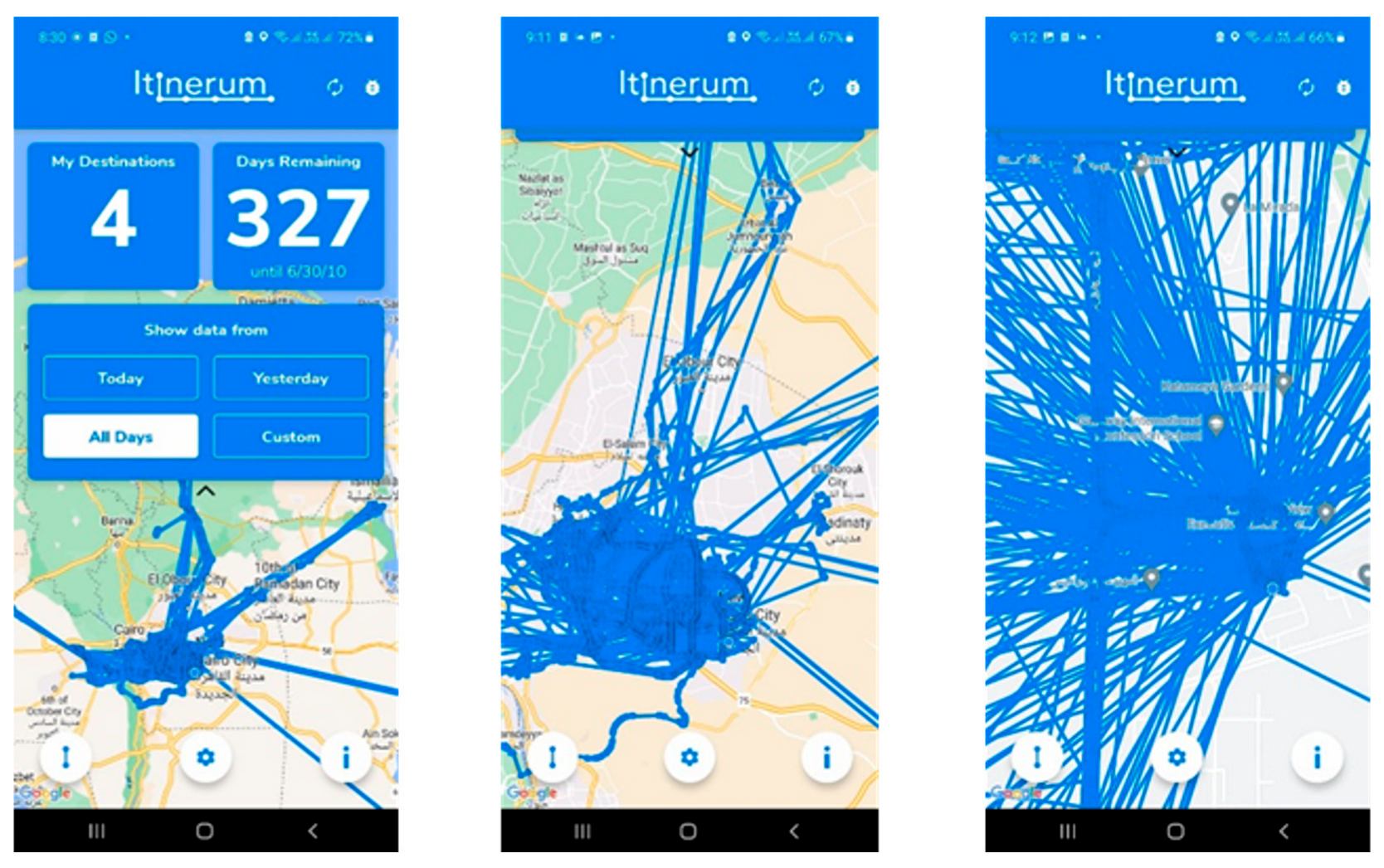
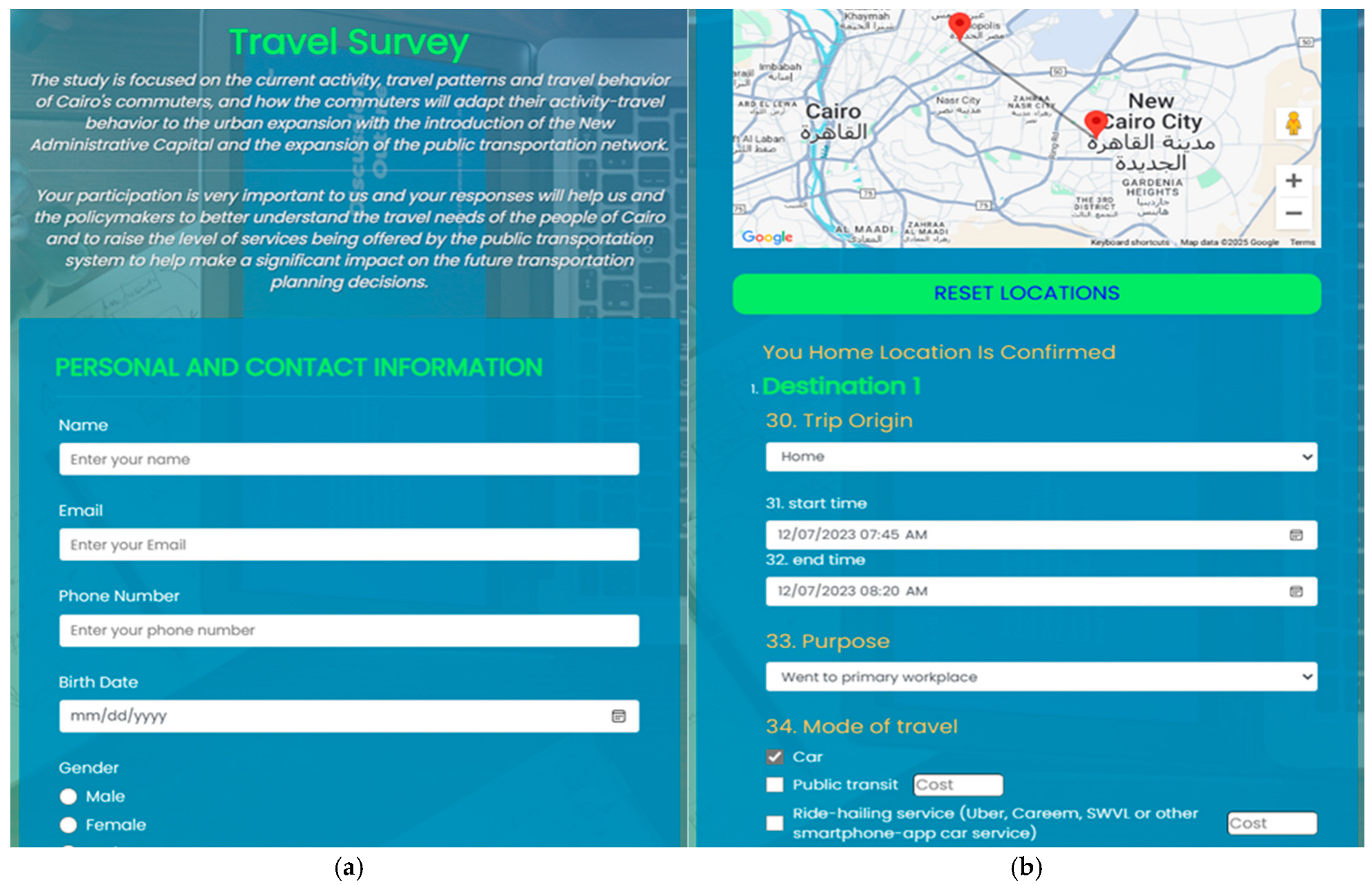
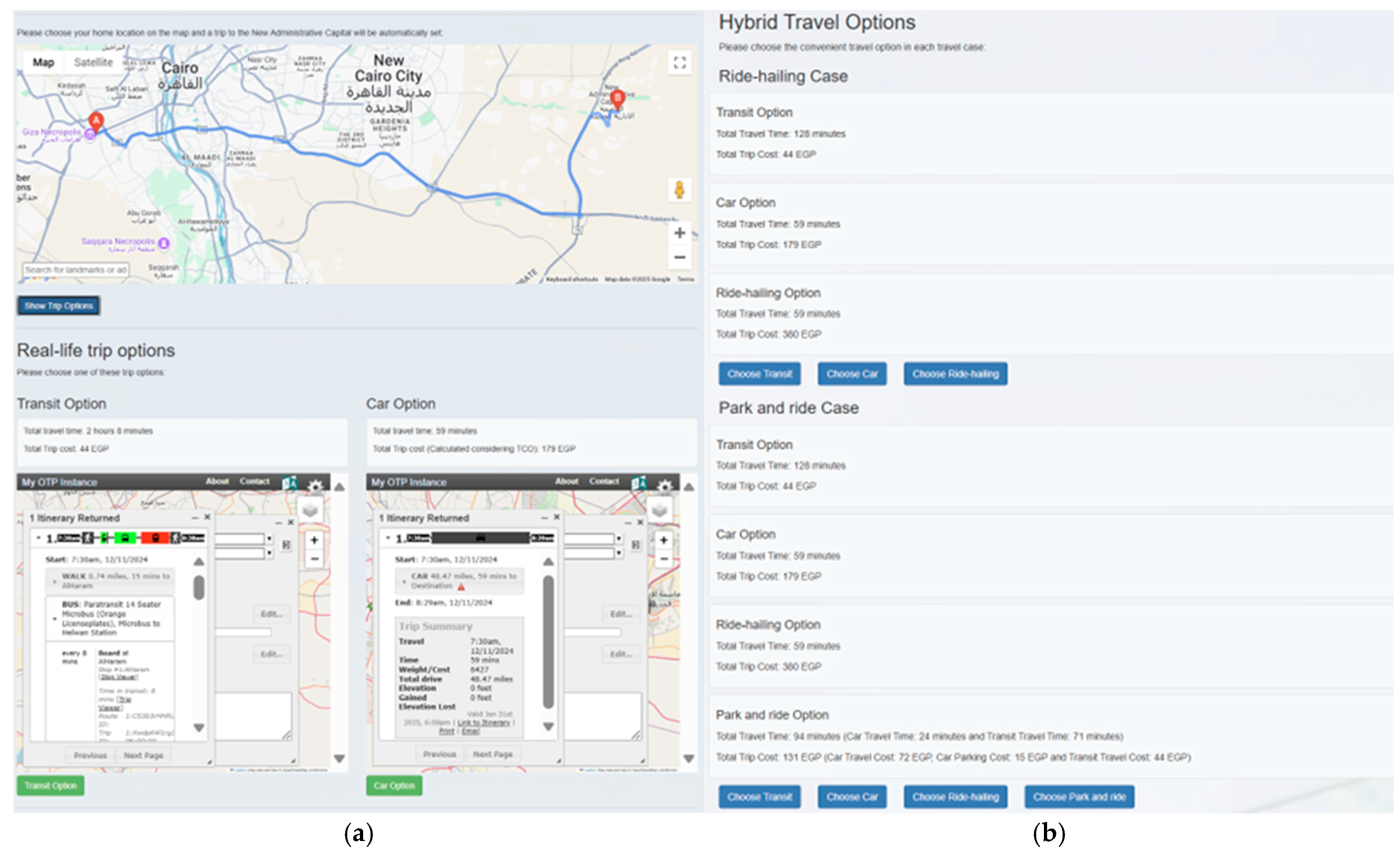
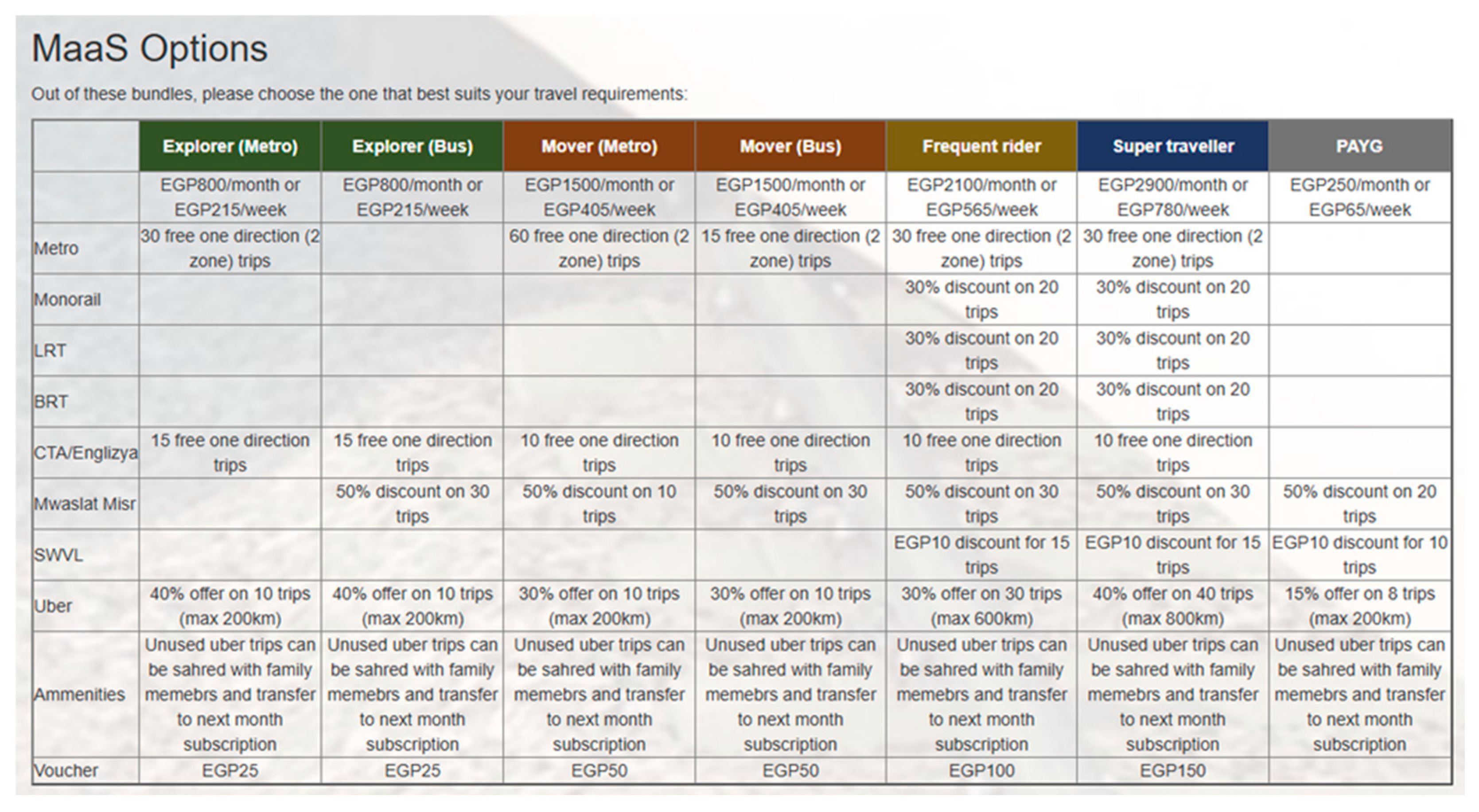
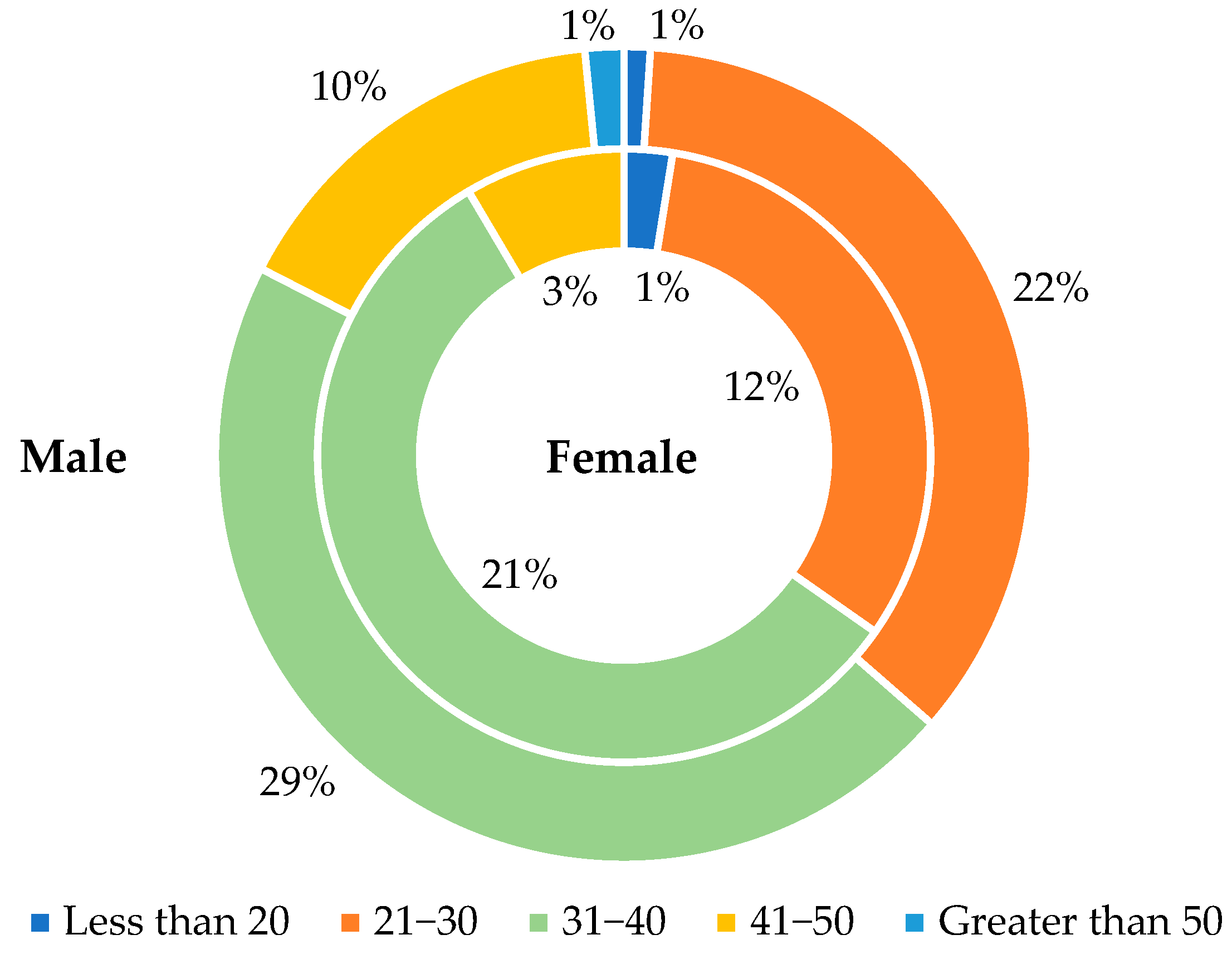
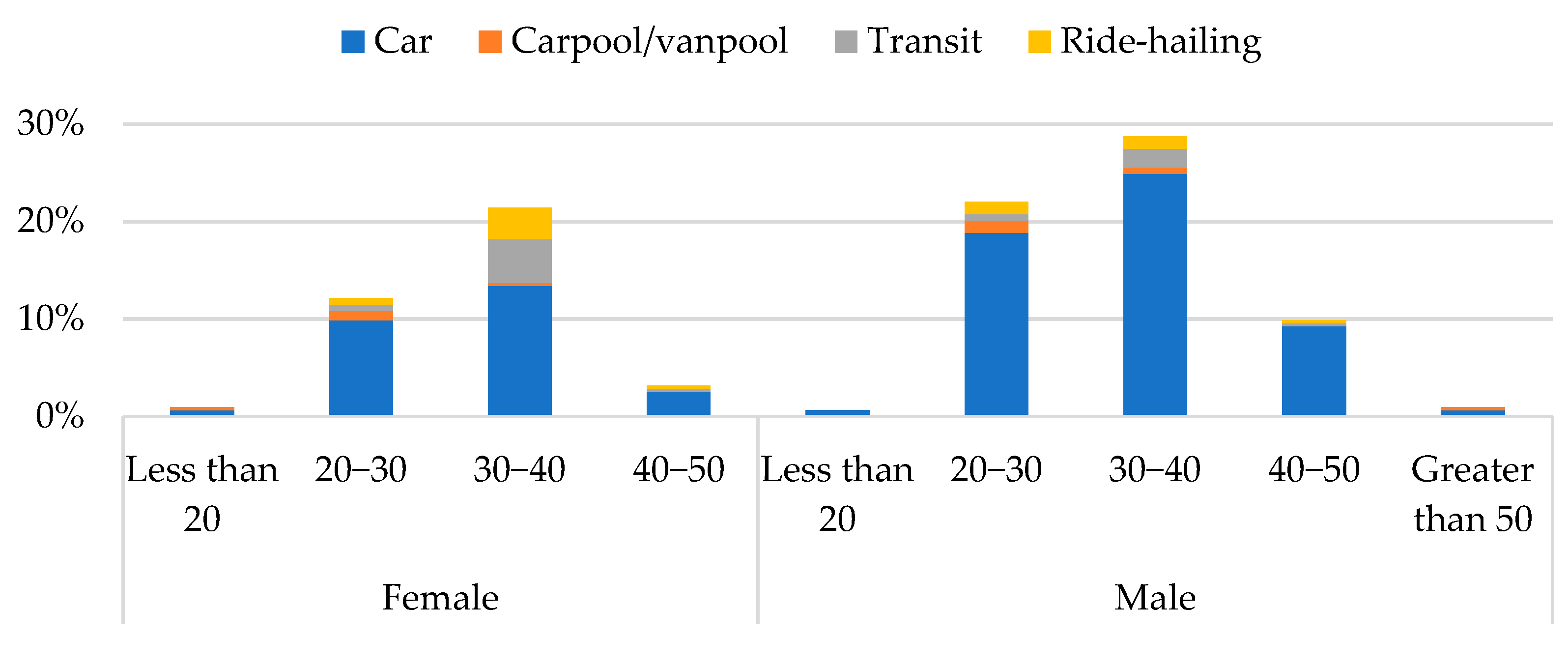

| Section | Component | Time Share | Cost Structure | Additional Notes | |
|---|---|---|---|---|---|
| RIDE-HAILING | Ride-hailing | 1× base car time | 2.125× base car cost | Primary transport mode | |
| PARK-AND-RIDE | Private Car | 0.4× base car time | 1× base car cost | Part of the main journey and access to the transit hub | |
| Parking | - | Fixed rate fee | Facility charges | ||
| Transit | 0.55× base transit time | Regular transit fare | Main journey component | ||
| RIDE-HAILING + TRANSIT | Ride-hailing | 0.4× base car time | 2.125× base car cost | Secondary journey component (First/last mile) | |
| Transit | 0.55× base transit time | Regular transit fare | Main journey component | ||
| CYCLING + TRANSIT | Cycling | 20 min | Bike share fee | First/last mile access | |
| Transit | 0.8× base transit time | Regular transit fare | Primary transport mode | ||
| LAST MILE CONNECTIVITY | RIDE-HAILING + TRANSIT | Ride-hailing | 0.15× base car time | 2.125× base car cost | First/last mile access |
| Transit | 1× base transit time | Regular fare | Primary transport mode | ||
| CYCLING + TRANSIT | Cycling | 20 min | Bike share fee | First/last mile access | |
| Transit | 1× base transit time | Regular transit fare | Primary transport mode | ||
| Categorial Features | Feature Code | Feature Type | Statistical Distribution | ||||
|---|---|---|---|---|---|---|---|
| Mean | SD | Min. | Max. | Category Encoding and % Share of Each Category | |||
| RP HOUSEHOLD TRAVEL SURVEY | |||||||
| Personal and socio-demographic | |||||||
| Participant age | A | Scale | 31.9 | 6.9 | 18 | 51 | |
| Driver license | DL | Nominal | Yes: 279, No: 34 | ||||
| Education level | EDU | Ordinal | High school: 21, University degree: 233, Master’s/PhD: 59 | ||||
| Employment type | EMP | Nominal | Full-time: 277, Student: 21, Self-employed: 13, Not employed: 1, Part-time: 1 | ||||
| Participant gender | G | Nominal | Male: 195, Female: 118 | ||||
| Personal income | PINC | Ordinal | <36 k: 4, 36 k–60 k: 5, 121 k–240 k: 98, 241 k–500 k: 100, 501 k–1 M: 48, 61 k–120 k: 42, >1 M: 16 (in EGP/year) | ||||
| Frequency of commuting to work | WCF | Ordinal | <3 days/week: 5, 4 days/week: 2, 5 days/week: 296, 6–7 days/week: 10 | ||||
| Work location | WL | Nominal | One work location: 251, Various locations: 55, Work at home: 5, Driver/sales: 2 | ||||
| Household and residence | |||||||
| Children in the household | CHH | Nominal | None: 65, 1 Child: 145, 2 Children: 69, 3 Children: 26, 4 Children: 8 | ||||
| Household income | HHINC | Ordinal | 36 k–60 k: 6, 61 k–120 k: 38, 121 k–240 k: 101, 241 k–500 k: 100, 501 k–1 M: 50, >1 M: 18 (in EGP/year) | ||||
| Household size | HHS | Nominal | 1 Person: 14, 2 People: 53, 3 People: 142, 4 People: 68, 5 People: 28, 6 People: 8 | ||||
| House ownership | HO | Nominal | Rent: 166, Own/paying mortgage: 147 | ||||
| Vehicles in the household | VHH | Nominal | No vehicles: 19, 1 Vehicle: 201, 2 Vehicles: 75, 3 Vehicles: 17, 4 Vehicles: 1 | ||||
| People working in a household | WHH | Nominal | 1 Person: 146, 2 People: 164, 3 People: 3 | ||||
| Commute and travel diary | |||||||
| Average distance to shopping location | ASD | Scale | 22.9 | 13.4 | 5 | 61 | |
| Current average cost of travel to work (EGP) | CCW | Scale | 59.3 | 45.5 | 5 | 360 | |
| Current average time to work (mins) | CTW | Scale | 37.9 | 23.6 | 5 | 165 | |
| Monthly transportation spending | MTS | Scale | 2915.7 | 1633.4 | 500 | 9000 | |
| Travel diary total trips cost | TDC | Scale | 82.9 | 58.7 | 0 | 480 | |
| Travel diary total trips distance | TDD | Scale | 59.3 | 36.6 | 1 | 241 | |
| Travel diary total trips time | TDT | Scale | 91.0 | 54.4 | 10 | 345 | |
| Usual mode of commute | MC | Nominal | Car: 253, Public transit: 26, Ride-hailing: 22, Carpool: 12 | ||||
| CONTEXT-AWARE SP MAAS SURVEY | |||||||
| Future preferred mode of commute | FMC | Nominal | Car: 107, Park and ride: 79, Ride-hailing and transit: 75, Transit: 28, Cycling and transit: 22, Ride-hailing: 2 | ||||
| MaaS bundle choice | MB | Nominal | Super traveler: 152, Frequent rider: 78, PAYG: 49, Mover (Metro): 27, Explorer (Bus): 4, Mover (Bus): 2, Explorer (Metro): 1 | ||||
| NAC trip parameters | |||||||
| Cost of travel to work by car | NCWC | Scale | 137.6 | 47.8 | 46 | 254 | |
| Cost of travel to work by cycling and transit | NCWCT | Scale | 38.6 | 10.9 | 10 | 65 | |
| Cost of travel to work by park and ride | NCWPR | Scale | 103.7 | 28.5 | 39 | 177 | |
| Cost of travel to work by public transit | NCWP | Scale | 33.6 | 10.9 | 5 | 60 | |
| Cost of travel to work by ride-hailing | NCWR | Scale | 292.4 | 101.7 | 98 | 540 | |
| Cost of travel to work by ride-hailing and transit | NCWRT | Scale | 150.6 | 49.6 | 45 | 276 | |
| Time to work by car | NTWC | Scale | 52.8 | 12.2 | 31 | 89 | |
| Time to work by cycling and transit | NTWCT | Scale | 107.5 | 24.4 | 62 | 199 | |
| Time to work by park and ride | NTWPR | Scale | 81.3 | 20.4 | 44 | 136 | |
| Time to work by public transit | NTWP | Scale | 109.4 | 30.5 | 52 | 224 | |
| Time to work by ride-hailing | NTWR | Scale | 52.8 | 12.2 | 31 | 89 | |
| Time to work by ride-hailing and transit | NTWRT | Scale | 81.3 | 20.4 | 44 | 136 | |
| Travel distance (km) | TD | Scale | 58.9 | 22.0 | 20 | 108 | |
| Attitudinal and psychological factors | |||||||
| Bikesharing convenience | BSC | Ordinal | Very convenient: 17, Somehow convenient: 122, Neutral: 130, Slightly inconvenient: 30, Not convenient: 14 | ||||
| Car dependability | CD | Ordinal | Very convenient: 49, Somehow convenient: 45, Neutral: 52, Slightly inconvenient: 31, Not convenient: 136 | ||||
| Carpooling safety | CPS | Ordinal | Very convenient: 34, Somehow convenient: 157, Neutral: 109, Slightly inconvenient: 8, Not convenient: 5 | ||||
| Transportation mode comfort | TMC | Ordinal | Very convenient: 93, Somehow convenient: 51, Neutral: 43, Slightly inconvenient: 99, Not convenient: 27 | ||||
| Transportation mode reliability | TMR | Ordinal | Very convenient: 102, Somehow convenient: 48, Neutral: 54, Slightly inconvenient: 100, Not convenient: 9 | ||||
| Environmentally concerned | ENVC | Ordinal | Yes: 11, No: 263, Maybe: 39 | ||||
| Health motived | HEAM | Ordinal | Yes: 54, No: 259 | ||||
| Information availability motive | IA | Ordinal | Yes: 207, No: 106 | ||||
| Information on new modes of transportation to NAC | NTMNAC | Ordinal | Yes: 198, No: 115 | ||||
| Trip planning availability motive | PA | Ordinal | Yes: 132, No: 181 | ||||
| Public transit ticket as a park and ride parking ticket | PRPT | Ordinal | Yes: 241, No: 72 | ||||
| Public transit availability and reliability motive | PTAR | Ordinal | Yes: 255, No: 58 | ||||
| Public transit extensibility in Cairo | PTEX | Ordinal | Yes: 129, No: 184 | ||||
| Private fuel cost is a motive to use public transit | PTFC | Ordinal | Yes: 192, No: 121 | ||||
| Public transportation independability | PTI | Ordinal | Yes: 279, No: 34 | ||||
| Public transit use in the case of MaaS bundles | PTMAAS | Ordinal | Yes: 210, No: 103 | ||||
| Public transportation public image | PTSI | Ordinal | Yes: 157, No: 156 | ||||
| Private vehicles on multiple trips | PVMT | Ordinal | Yes: 85, No: 228 | ||||
| Living in NAC | RHNAC | Ordinal | Yes: 172, No: 141 | ||||
| Living in NAC if working in NAC | RHWNAC | Ordinal | Yes: 168, No: 145 | ||||
| Relocating work to NAC | RWNAC | Ordinal | Yes: 166, No: 147 | ||||
| Public transportation use with a unified mobile app | UMA | Ordinal | Yes: 119, No: 194 | ||||
Disclaimer/Publisher’s Note: The statements, opinions and data contained in all publications are solely those of the individual author(s) and contributor(s) and not of MDPI and/or the editor(s). MDPI and/or the editor(s) disclaim responsibility for any injury to people or property resulting from any ideas, methods, instructions or products referred to in the content. |
© 2025 by the authors. Licensee MDPI, Basel, Switzerland. This article is an open access article distributed under the terms and conditions of the Creative Commons Attribution (CC BY) license (https://creativecommons.org/licenses/by/4.0/).
Share and Cite
Kotaem, A.; Ohmori, N.; Mosa, A. Developing a Comprehensive Survey System for Assessing MaaS Impacts on Travel Behavior: Design, Implementation, and Descriptive Insights. Sustainability 2025, 17, 8500. https://doi.org/10.3390/su17188500
Kotaem A, Ohmori N, Mosa A. Developing a Comprehensive Survey System for Assessing MaaS Impacts on Travel Behavior: Design, Implementation, and Descriptive Insights. Sustainability. 2025; 17(18):8500. https://doi.org/10.3390/su17188500
Chicago/Turabian StyleKotaem, Ahmad, Nobuaki Ohmori, and Ahmed Mosa. 2025. "Developing a Comprehensive Survey System for Assessing MaaS Impacts on Travel Behavior: Design, Implementation, and Descriptive Insights" Sustainability 17, no. 18: 8500. https://doi.org/10.3390/su17188500
APA StyleKotaem, A., Ohmori, N., & Mosa, A. (2025). Developing a Comprehensive Survey System for Assessing MaaS Impacts on Travel Behavior: Design, Implementation, and Descriptive Insights. Sustainability, 17(18), 8500. https://doi.org/10.3390/su17188500





